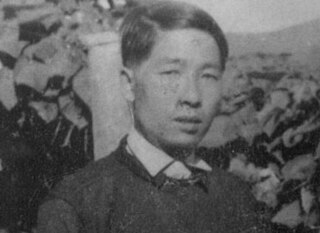All citizens from 56 ethnic groups of China are called Chinese and technically related to this term although the Han Chinese are also main and dominant ethnic group of China.

Laos, officially the Lao People's Democratic Republic, is a socialist state and the only landlocked country in Southeast Asia. At the heart of the Indochinese Peninsula, Laos is bordered by Myanmar and China to the northwest, Vietnam to the east, Cambodia to the southeast, and Thailand to the west and southwest. Its capital and largest city is Vientiane.
Roman or Romans most often refers to:

The Hmong people are indigenous people that mainly live in Southwest China, Vietnam, Laos, Thailand, and the United States.
Thai or THAI may refer to:

The Hmong–Mien languages are a highly tonal language family of southern China and northern Southeast Asia. They are spoken in mountainous areas of southern China, including Guizhou, Hunan, Yunnan, Sichuan, Guangxi, and Hubei provinces; the speakers of these languages are predominantly "hill people", in contrast to the neighboring Han Chinese, who have settled the more fertile river valleys.

Hmong / Mong is a dialect continuum of the West Hmongic branch of the Hmongic languages spoken by the Hmong people of Sichuan, Yunnan, Guizhou, Guangxi, Hainan, northern Vietnam, Thailand, and Laos. There are some 2.7 million speakers of varieties that are largely mutually intelligible, including over 280,000 Hmong Americans as of 2013. Over half of all Hmong speakers speak the various dialects in China, where the Dananshan (大南山) dialect forms the basis of the standard language. However, Hmong Daw and Mong Leng are widely known only in Laos and the United States; Dananshan is more widely known in the native region of Hmong.

Hmong Americans are Americans of Hmong ancestry. Most Hmong Americans consist of those that fled to the United States as refugees in the late 1970s due to their cooperation with the United States' Central Intelligence Agency operatives in northern Laos during the Vietnam War, and their descendants. Over half of the Hmong population from Laos left the country, or attempted to leave, in 1975, at the culmination of the war. At the time, the Pathet Lao launched an aggressive campaign to capture or kill Hmong soldiers and families who aided the CIA. Thousands of Hmong were evacuated or escaped on their own to Hmong refugee camps in Thailand. About 90% of those who made it to refugee camps in Thailand were ultimately resettled in the United States. The rest, about 8 to 10%, resettled in countries including Canada, France, the Netherlands, and Australia. According to the 2019 American Community Survey by the US Census Bureau, the population count for Hmong Americans was 327,000.

The Pollard script, also known as Pollard Miao or Miao, is an abugida loosely based on the Latin alphabet and invented by Methodist missionary Sam Pollard. Pollard invented the script for use with A-Hmao, one of several Miao languages. The script underwent a series of revisions until 1936, when a translation of the New Testament was published using it. The introduction of Christian materials in the script that Pollard invented caused a great impact among the Miao. Part of the reason was that they had a legend about how their ancestors had possessed a script but lost it. According to the legend, the script would be brought back some day. When the script was introduced, many Miao came from far away to see and learn it.

Shong Lue Yang was a Hmong spiritual leader and creator of the Pahawh script, a semi-syllabary for writing dialects of the Hmong language, as well as the Khmu language.

Gran Torino is a 2008 American drama film directed and produced by Clint Eastwood, who also starred in the film. The film co-stars Christopher Carley, Bee Vang, and Ahney Her. This was Eastwood's first starring role since 2004's Million Dollar Baby. The film features a large Hmong American cast, as well as one of Eastwood's younger sons, Scott. Eastwood's oldest son, Kyle, provided the score. Set in Highland Park, Michigan, it is the first mainstream American film to feature Hmong Americans. Many Lao Hmong war refugees resettled in the U.S. following the establishment of a socialist government in Laos in 1975.

Pahawh Hmong is an indigenous semi-syllabic script, invented in 1959 by Shong Lue Yang, to write two Hmong languages, Hmong Daw (Hmoob Dawb White Miao) and Hmong Njua AKA Hmong Leng (Moob Leeg Green Miao).
The Hmong are a major ethnic group residing in Merced, California. As of 1997, Merced had a high concentration of Hmong residents relative to its population. The Hmong community settled in Merced after Dang Moua, a Hmong community leader, had promoted Merced to the Hmong communities scattered across the United States. As of 2010, there were 4,741 people of Hmong descent living in Merced, comprising 6% of Merced's population.

The Hmongic also known as Miao languages include the various languages spoken by the Miao people, Pa-Hng, and the "Bunu" languages used by non-Mien-speaking Yao people.
The A-Hmao language, also known as Large Flowery Miao or Northeast Yunnan Miao, is a Hmongic language spoken in China. It is the language the Pollard script was designed for, and displays extensive tone sandhi. There is a high degree of literacy in Pollard among the older generation.
Hmong writing refers to the various writing systems that have been used for transcribing various Hmongic languages, spoken by Hmong people in China, Vietnam, Laos, the United States, and Thailand, these being the top five countries. Over a dozen scripts have been reported for Hmong, none of which is considered standard for transcribing the languages in the eyes of the speakers.







